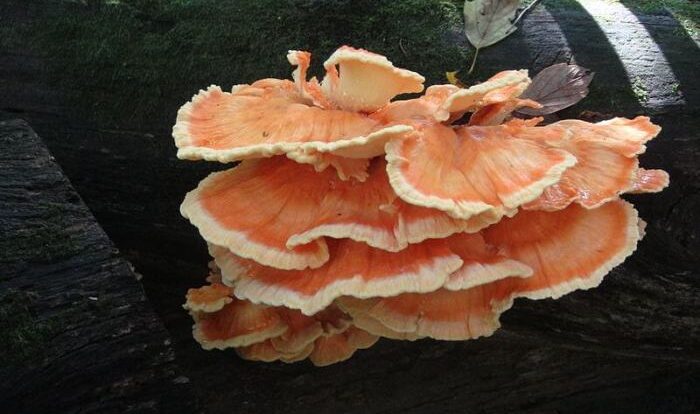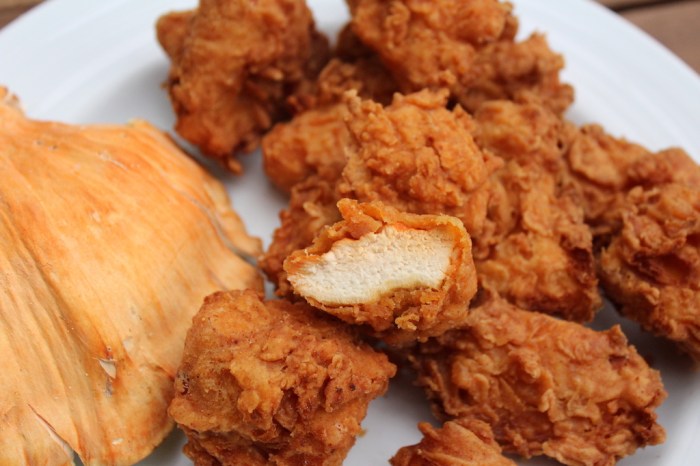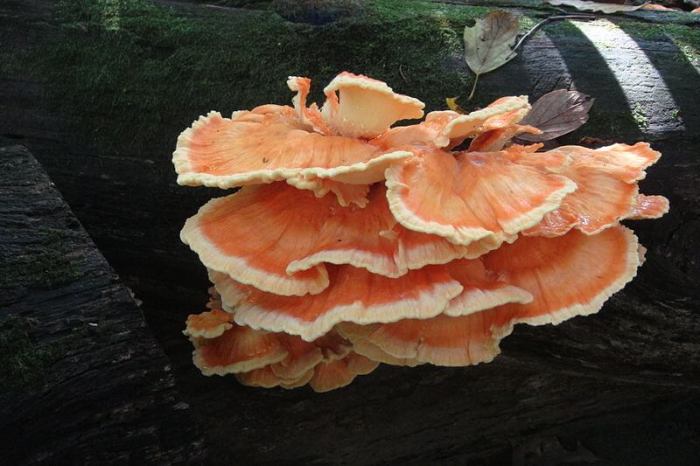
Embark on a culinary adventure with our comprehensive chicken of the woods recipe guide. From identifying the edible varieties to mastering versatile cooking techniques, this guide empowers you to savor the unique flavors of this woodland delicacy.
Discover the fascinating characteristics of chicken of the woods, its nutritional benefits, and the optimal methods for harvesting and preparing it. Our detailed recipe will inspire you to create a delectable dish that showcases the earthy essence of this wild mushroom.
Identifying Edible Chicken of the Woods
Identifying edible chicken of the woods is crucial to avoid potential health risks. This mushroom’s distinctive characteristics can help you distinguish it from inedible varieties.
Physical Characteristics
- Color:Bright orange to yellow, with white to pale yellow pores.
- Shape:Irregular, with overlapping layers or shelves that resemble a chicken’s comb.
- Texture:Soft and spongy when young, becoming tougher with age.
- Size:Can range from small clusters to large, fan-shaped structures.
Types of Chicken of the Woods
Several species of chicken of the woods exist, and not all are edible:
- Laetiporus sulphureus(True Chicken of the Woods): Edible and the most common type found in North America and Europe.
- Laetiporus conifericola(False Chicken of the Woods): Inedible and may cause stomach upset.
Distinguishing Edible from Inedible Varieties
To ensure you’re consuming edible chicken of the woods, consider these tips:
- Smell:Edible varieties have a pleasant, fruity aroma, while inedible ones may have a foul odor.
- Habitat:Edible chicken of the woods grows on dead or dying hardwood trees, such as oak, maple, and birch.
- Pores:Edible species have small, white to pale yellow pores, while inedible ones have larger, darker pores.
- Season:Edible chicken of the woods is typically found in late summer to early fall.
Harvesting and Preparing Chicken of the Woods
Harvesting chicken of the woods at the right time and location is crucial for ensuring its freshness and flavor. Cleaning and storing the mushrooms properly will extend their shelf life and preserve their nutritional value.
If you’re looking for a unique and delicious way to enjoy the flavors of the forest, check out this chicken of the woods recipe . This edible mushroom is known for its meaty texture and savory flavor, making it a great substitute for chicken in many dishes.
The recipe is easy to follow and can be customized to your liking, so give it a try and let us know what you think!
Harvesting Chicken of the Woods
- Optimal Time:Chicken of the woods is typically ready to harvest from late spring to early fall. Look for mushrooms that are firm and have a bright orange or yellow color.
- Ideal Location:These mushrooms can be found on dead or dying hardwood trees, especially oaks, maples, and beeches. They often grow in clusters or shelves on the sides of trees.
- Harvesting Techniques:Use a sharp knife to cut the mushrooms cleanly from the tree. Avoid pulling or tearing them, as this can damage the mycelium and prevent future growth.
Cleaning Chicken of the Woods
- Remove Debris:Gently brush off any dirt or debris from the mushrooms using a soft brush or a damp cloth.
- Trim Tough Parts:Cut away any tough or woody parts of the mushrooms, such as the base of the stems.
- Rinse Thoroughly:Rinse the mushrooms briefly under cold running water to remove any remaining dirt or insects.
Storing Chicken of the Woods
- Fresh Mushrooms:Store fresh chicken of the woods in a paper bag or a loosely covered container in the refrigerator for up to 5 days.
- Dried Mushrooms:To preserve chicken of the woods for longer, you can dry them. Slice the mushrooms thinly and spread them on a drying rack or baking sheet. Place them in a warm, dry place with good air circulation until they are completely dry and brittle.
If you’re looking for a unique culinary experience, look no further than the chicken of the woods. This edible mushroom is a dead ringer for chicken meat, making it a perfect substitute in any dish. For a mouthwatering treat, try this chicken of the woods recipe .
Store dried mushrooms in an airtight container in a cool, dark place for several months.
Nutritional Benefits of Chicken of the Woods

Chicken of the woods is not only a delectable mushroom but also a nutritional powerhouse. It boasts an impressive array of essential vitamins, minerals, and antioxidants, making it a valuable addition to a healthy diet.
Vitamins
- Vitamin D:Chicken of the woods is a rich source of vitamin D, essential for bone health and immune function.
- Vitamin B vitamins:It contains several B vitamins, including niacin, riboflavin, and thiamine, which support energy metabolism and nerve function.
- Vitamin C:This mushroom provides a significant amount of vitamin C, a potent antioxidant that helps protect cells from damage.
Minerals
- Potassium:Chicken of the woods is an excellent source of potassium, which plays a crucial role in regulating blood pressure and fluid balance.
- Phosphorus:It also contains phosphorus, essential for strong bones and teeth.
- Iron:This mushroom provides some iron, a mineral necessary for red blood cell production and oxygen transport.
Antioxidants
Chicken of the woods is a rich source of antioxidants, including ergothioneine and beta-glucans. These antioxidants help protect the body from oxidative stress, which can contribute to aging and chronic diseases.
Versatile Cooking Applications: Chicken Of The Woods Recipe

Chicken of the woods offers a versatile culinary experience, lending itself to various cooking methods that bring out its unique flavors and textures.
When cooked, chicken of the woods takes on a meaty, umami-rich flavor profile with a slightly chewy texture. It can be sautéed, grilled, roasted, or fried, each method imparting distinct characteristics.
Who needs chicken when you can have chicken of the woods? This funky fungus is not only delicious but also a great source of nutrients. Check out this chicken of the woods recipe to get your hands on a savory and healthy meal.
Sautéing, Chicken of the woods recipe
- Sautéing chicken of the woods in butter or olive oil brings out its earthy flavors while creating a tender and juicy texture.
- Season with salt, pepper, and herbs like thyme or rosemary for added depth of flavor.
Grilling
- Grilling chicken of the woods over medium heat imparts a smoky, charred flavor.
- Brush with a marinade of olive oil, soy sauce, and honey for a sweet and savory glaze.
Roasting
- Roasting chicken of the woods in the oven at high heat creates a crispy exterior and a tender interior.
- Toss with olive oil, salt, and pepper before roasting, and add vegetables like carrots or potatoes for a complete meal.
Frying
- Frying chicken of the woods in a tempura batter or breadcrumbs results in a crispy, golden-brown exterior.
- Serve with dipping sauces like ranch or barbecue sauce.
Chicken of the woods pairs well with a variety of ingredients and flavors. It can be incorporated into salads, soups, stews, and even pizzas. Its meaty texture makes it an excellent substitute for chicken or beef in many dishes.
Detailed Recipe Creation

Creating a delicious chicken of the woods dish is a rewarding experience that allows you to savor the unique flavors of this edible fungus. Here’s a comprehensive recipe that will guide you through the process, ensuring a tasty and satisfying meal.
Ingredients
- 1 pound fresh chicken of the woods, cleaned and torn into bite-sized pieces
- 1 tablespoon olive oil
- 1/2 onion, chopped
- 2 cloves garlic, minced
- 1/2 cup vegetable broth
- 1/4 cup white wine (optional)
- 1 tablespoon dried thyme
- 1/2 teaspoon salt
- 1/4 teaspoon black pepper
- 1/4 cup chopped fresh parsley
Variations and Substitutions
- For a richer flavor, use butter instead of olive oil.
- If you don’t have vegetable broth, use water instead.
- Substitute dry white wine with lemon juice for a similar acidity.
- Add other vegetables to your dish, such as sliced mushrooms or chopped bell peppers.
- For a creamy texture, stir in a splash of heavy cream or sour cream.
Step-by-Step Instructions
- Heat the olive oil in a large skillet over medium heat.
- Add the onion and garlic and cook until softened, about 5 minutes.
- Add the chicken of the woods and cook until browned on all sides, about 10 minutes.
- Pour in the vegetable broth and white wine (if using) and bring to a boil.
- Reduce heat to low, cover, and simmer for 15 minutes, or until the chicken of the woods is tender.
- Stir in the thyme, salt, and pepper.
- Cook for an additional 5 minutes, or until the sauce has thickened.
- Garnish with fresh parsley and serve immediately.
Final Conclusion

As you delve into the world of chicken of the woods, you’ll not only enjoy its culinary delights but also appreciate its ecological significance. This guide provides a holistic understanding of this remarkable mushroom, enabling you to forage, cook, and savor it responsibly.
Essential Questionnaire
Is chicken of the woods safe to eat?
Yes, edible chicken of the woods is safe to eat and prized for its unique flavor and texture.
How do I identify edible chicken of the woods?
Edible chicken of the woods has a bright orange to yellow color, a velvety texture, and gills that run down the stem.
What are the nutritional benefits of chicken of the woods?
Chicken of the woods is rich in fiber, vitamins, and minerals, including vitamin D, potassium, and iron.
